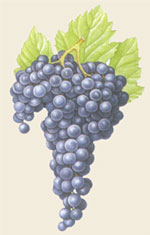


Merlot is to the right-bank vineyards of Bordeaux what Cabernet Sauvignon is to the left-bank, Medoc, districts. It is the key to the great red wines of St-Emilion and Pomerol, though not always dominant in percentage terms in the blend. The important role it plays in some great names (Ch Petrus, particularly) has led California winemakers to experiment with the variety.
On a less exalted level, Merlot is widely grown in southern France, where it increasingly figures on vins de pays labels, and in northern Italy. Many of the minor Bordeaux religions grow more Merlot than cabernets. Merlot is used even in the Medoc because it ripens earlier than Cabernet Sauvignon. However, this makes it vulnerable to spring frosts and it is also susceptible to coulure and other damage, and in some vintages Merlot vines yield hardly any grapes: 1984 is remembered in Bordeaux as a vintage made almost entirely from Cabernet.
Merlot made unblended offers a soft, earthy, fruity taste, a dark, rich colour, and a simple and direct aroma. Most Merlot wine is made to be drunk young, the exceptions, such as the great Pomerols, age into a wine of superb complexity. It is not yet clear whether New World Merlots will match this longevity, but much money and effort is being put behind it.
|
|
|




